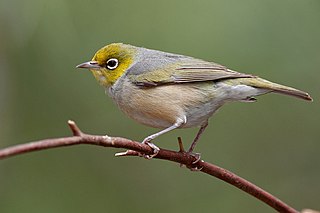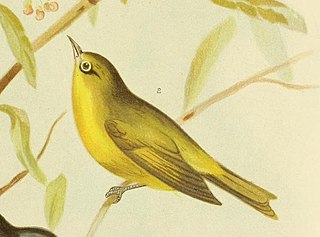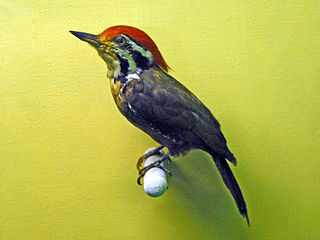
Zosterops is a genus of passerine birds containing the typical white-eyes in the white-eye family Zosteropidae. The genus has the largest number of species in the white-eye family. They occur in the Afrotropical, Indomalayan, and Australasian realms. Typical white-eyes have a length of between 8 and 15 cm. Their most characteristic feature is a conspicuous white feather ring around the eye, though some species lack it. The species in this group vary in the structural adaptations of the tongue. The Zosterops [griseotinctus] group is an example of a "great speciator" inhabiting a vast area and showing a remarkable morphological differentiation on islands, some of which maybe as close as 2 km (1.2 mi) apart.

The common green magpie is a member of the crow family, roughly about the size of the Eurasian jay or slightly smaller. In the wild specimens are usually a bright green colour, slightly lighter on the underside and has a thick black stripe from the bill to the nape. Compared to the other members of its genus, the white-tipped tail is quite long. This all contrasts vividly with the red fleshy eye rims, bill and legs. The wings are reddish maroon.

The white-eyes are a family, Zosteropidae, of small passerine birds native to tropical, subtropical and temperate Sub-Saharan Africa, southern and eastern Asia, and Australasia. White-eyes inhabit most tropical islands in the Indian Ocean, the western Pacific Ocean, and the Gulf of Guinea. Discounting some widespread members of the genus Zosterops, most species are endemic to single islands or archipelagos. The silvereye, Zosterops lateralis, naturally colonised New Zealand, where it is known as the "wax-eye" or tauhou ("stranger"), from 1855. The silvereye has also been introduced to the Society Islands in French Polynesia, while the Japanese white-eye has been introduced to Hawaii.

The silvereye or wax-eye, also known by its Māori name tauhou, is a very small omnivorous passerine bird of the south-west Pacific. In Australia and New Zealand its common name is sometimes white-eye, but this name is more commonly used to refer to all members of the genus Zosterops, or the entire family Zosteropidae.

The Indian white-eye, formerly the Oriental white-eye, is a small passerine bird in the white-eye family. It is a resident breeder in open woodland on the Indian subcontinent. They forage in small groups, feeding on nectar and small insects. They are easily identified by the distinctive white eye-ring and overall yellowish upperparts. The range previously extended eastwards to Southeast Asia, Indonesia and Malaysia. Their name was recently changed due to previous members of Zosterops palpebrosus in Southeast Asia being renamed to a new species, making the Indian White-eye a more geographically accurate term for this species.

The warbling white-eye, also known as the Japanese white-eye and mountain white-eye, is a small passerine bird in the white-eye family. The specific epithet is occasionally written japonica, but this is incorrect due to the gender of the genus. Its native range includes much of East Asia, including the Russian Far East, Japan, Indonesia, Korea, and the Philippines. It has been intentionally introduced to other parts of the world as a pet and as pest control, with mixed results. As one of the native species of the Japanese islands, it has been depicted in Japanese art on numerous occasions, and historically was kept as a cage bird.

The banded broadbill is a species of bird in the Eurylaimidae typical broadbill family found in Mainland Southeast Asia and the Greater Sunda Islands. It is sometimes split into two species, one including only the nominate subspecies, E. j. javanicus, and one including all the remaining subspecies. It inhabits a variety of forests, along with forest edge, rubber plantations and Falcataria falcata groves, mainly in lowland areas. A striking, large-bodied bird with a length of 21.5–23.0 cm (8.5–9.1 in), it is unlikely to be mistaken for another species. The broadbill is mostly purplish-red, with yellow-streaked black wings, a bright blue beak, a blackish face and greyish chin and upper breast. Females can be told apart from males by their lack of a black neckband, although these are indistinct in Bornean and Javan males. Despite its conspicuous appearance, the bird is usually hard to see due to its sluggishness and is usually only noticed when it vocalises.

The Vanuatu white-eye or yellow-fronted white-eye is a small passerine bird belonging to the genus Zosterops in the white-eye family Zosteropidae. It is endemic to Vanuatu, where it is one of the most common birds.

The large woodshrike is found in south-eastern Asia, Sumatra, Java, and Borneo. Its natural habitats are temperate forest, subtropical or tropical moist lowland forest, subtropical or tropical mangrove forest, and subtropical or tropical moist montane forest.

The canary white-eye or yellow white-eye is a species of white-eye endemic to northern Australia in subtropical or tropical mangrove forests. Its common name reflects the circle of white feathers around its eye.

Heuglin's white-eye, also known as the Ethiopian white-eye, is a species of bird in the family Zosteropidae. It is found in north-eastern and eastern Africa, primarily in Ethiopia and Kenya. Its natural habitats range from subtropical or tropical moist montane forests, to subtropical or tropical high-altitude shrubland, plantations, and rural gardens.

The northern yellow white-eye, formerly the African yellow white-eye, is a species of bird in the family Zosteropidae. It is found across sub-Saharan Africa, from Senegal in the west across to southern Sudan in the east and south to northern Angola.

The olive-backed woodpecker is a species of bird in the woodpecker family Picidae that is found in Southeast Asia.
The Mbulu white-eye is a bird species in the family Zosteropidae. It is found in southern Kenya and northern Tanzania.

The pale white-eye also known as Kenya white-eye is a bird species in the family Zosteropidae. It is found in central and eastern Kenya and in eastern Tanzania.

The broad-ringed white-eye or Kilimanjaro white-eye is a bird species in the family Zosteropidae. It is found in northeast Tanzania.

Swinhoe's white-eye is a bird species in the white-eye family Zosteropidae. It is found in east China, Taiwan, north Vietnam, the Thai-Malay Peninsula, Sumatra and Borneo. Populations have also been introduced throughout Southern California.

The sangkar white-eye is a bird species in the family Zosteropidae. It is also known as the Sunda white-eye. It is found in forested habitats on the Indonesian islands of Java and Bali. In Java it is typically found at elevations between 200–1,600 m (660–5,250 ft), but it sometimes occurs at lower elevations as well.
The cream-eyed bulbul is a member of the bulbul family of passerine birds. It is endemic to the island of Borneo.

The Meratus white-eye is a species of bird in the white-eye family, Zosteropidae. The species was described in 2021 by the Indonesian ornithologist Mohammed Irham and his colleagues based on genetic, morphological, and vocal differences from other Zosterops white-eyes. It is endemic to the Meratus Mountains of Indonesian Borneo, where it has been recorded from Mount Besar and Mount Karokangen. It inhabits the mid and lower storeys of closed-canopy montane forests at elevations between 1,300 and 1,650 m. It is a typical Zosterops white-eye, with deep olive-green upperparts, yellower underparts, a yellow stripe across the lores, and a distinctive bicoloured bill. Adults have a length of around 11–12 cm (4.3–4.7 in) and a mass of 8.5–9.5 g (0.30–0.34 oz). Both sexes look alike.


















